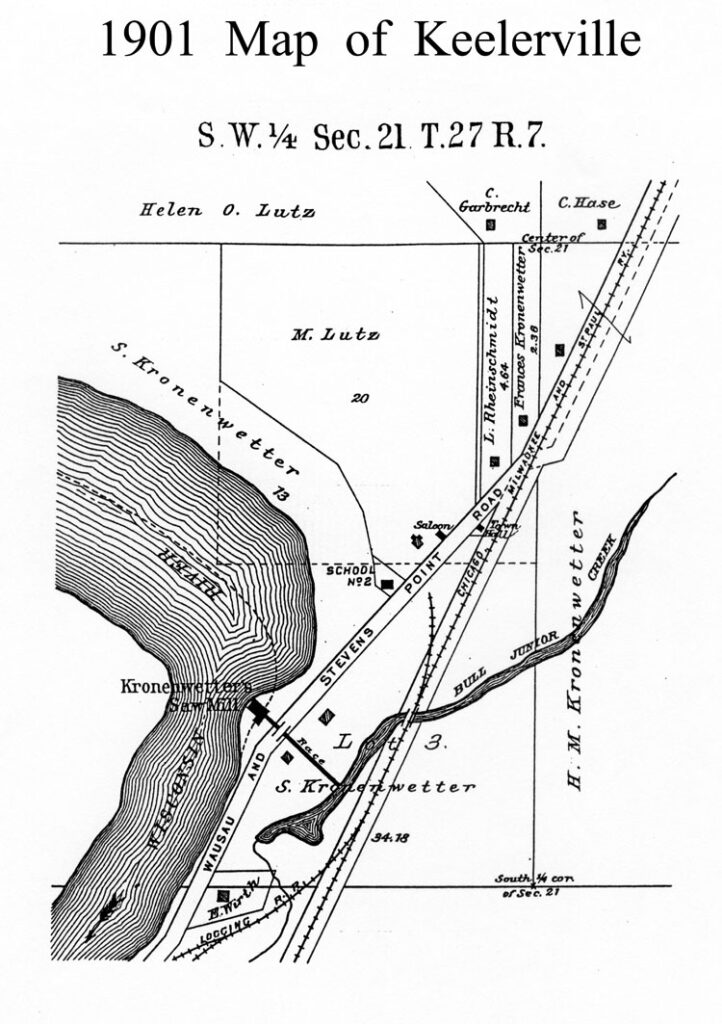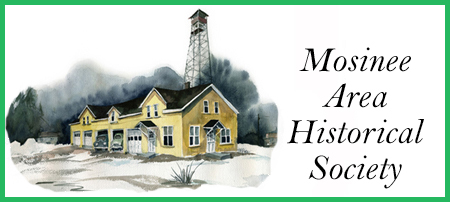
Keelerville
In 1845 Henry Merrill purchased the first land in the area. Between 1848 and 1852 Truman Keeler came to the area with his family. His son Castle Milo Keeler was born in the Mosinee area on August 21, 1848. Below is shown the 1849 Hathoway Survey of the Keelerville area with the dates land patents were given out on the land.
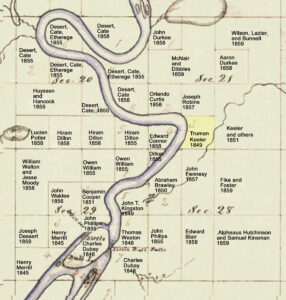
On November 1, 1849 Truman Keeler purchased Lot 3 in Township 27 North, Range 7 East, Section 21. On this land he would build a general store and a saw mill. The settlement that sprang up here would come to be known as Keelerville.
There appear to be no maps that ever formally had Keelerville’s location marked (The village was located on the north end of the current River Road, Mosinee, WI.)
A stream named “Little Bull Junior” that ran through his land and close to the Wisconsin River would supply the power for a mill.
In 1851 Truman Keeler would purchase more land jointly with others to supply lumber for the mill he built.
On March 18, 1852, a post office called the Little Bull Falls post office had been opened on the Wausau Plank Road at a site 1 ½ miles north of Blairs’ hotel. Truman Keeler is the first postmaster, with this post office residing inside his general store. The area surrounding the post office will soon come to be known as Keelerville. Anyone on the west bank of the river who wanted to receive or send mail had to make a water crossing to do so.
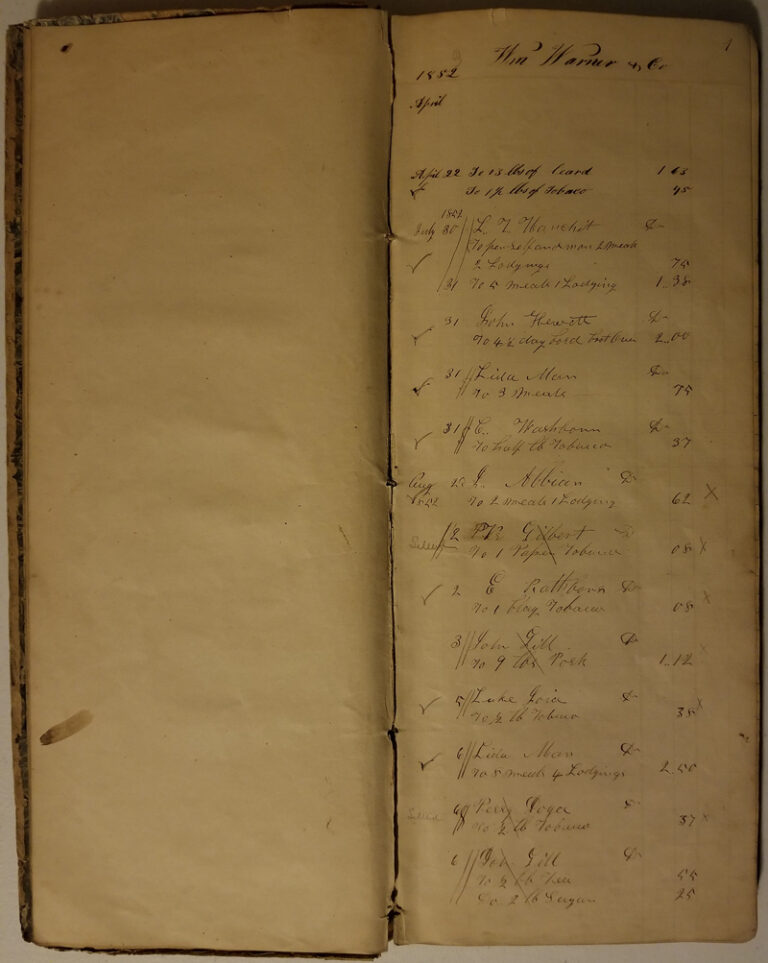
There exists a ledger from the General Store at Keelerville. The first entries begin in 1852.
The journal was held at a historical society in Kansas, where the Keeler family had later settled. The society sent the journal to the City of Mosinee, and the journal now resides in the possession of Al Erickson, who was mayor of Mosinee at the time the journal was sent to Mosinee. The Mosinee Area Historical Society holds a digital copy of the ledger.
By September of 1855, Truman Keeler had cut a canal from where Bull Junior Creek flowed nearest to the Wisconsin River and succeeded in re-routing the Bull Jr. Creek. He obtained a water drop sufficient to power the small sawmill he built. This was about one mile north of Little Bull Falls. Keelerville then had fifteen to twenty buildings. (as reported by the Wiscosnin Pinery newspaper, September 24, 1855)
In a bold move in the summer of 1857, Joseph Dessert and Henry Cate successfully had the Little Bull Falls post office moved to the west bank of the river. They renamed the post office the Mosinee Post Office and named Mr. Cate as post master, (post masters were elected positions at this time). On August 26, 1857 this article appeared in the Central Wisconsin newspaper.
“From a communication received by the Post Master of this village, from the “Post Office Department”, we learn that the name and site of the Post Office in this County known as Little Bull Falls, has been changed to Mosinee and Henry Cate appointed Post Master.”
In October of 1858, newspapers reported that Truman Keeler of Mosinee, was chosen to be president of the Republican Convention for Marathon County. Note the newspapers used Mosinee as Keeler’s location. Keelerville was never “recognized” as the name of the hamlet.
On the 1860 Federal Census for the Town of Mosinee, Truman Keeler was listed as engaged in lumbering. He was still operating the mill at Keelerville. His family continued to reside with him.
By 1860 , Aron Forbes, his parents, and his sister with her family were all in the Town of Mosinee in the Keelerville area. On the 1860 census Aron Forbes is listed as a saloon keeper with his parents living with him. Near to him, working a farm, lived his sister Hannah (age 52) with her husband John Durkee and their son Joseph (age21).
(On September 7th, 1850, Aron Forbes and his three children were listed on the Federal census in Indian Lands in Marquette County, Wisconsin. Forbes’ wife had passed away before he came west. Also listed are his mother Lydia and father Anthony (listed as Andrew). Aron’s younger brother John and John’s family are also on this census. On October 1, 1850, all the Forbes’ are again counted for the federal census, this time on the Winnebago County, Wisconsin Federal Census.)
For the next three years those now in Keelerville toiled to make their fortunes.
In April of 1863, Lydia Forbes nee Van Curler died at Keelerville. She was buried in a private family cemetery lot behind the Forbes tavern building.
Then, in late 1863 Truman Keeler sold the mill to William Gouldsbury and moved his family to Kansas.
The Keeler family members eventually settled in Houston, Smith County, Kansas (per the 1880 Federal Census).
William Gouldsbury continued to work this mill for seven years. (William Gouldsbury had first come to the Mosinee area in 1848. He partnered with J. P. and George Moore to operate the mill at Mosinee that was later owned by Joseph Dessert.)
Anthony Forbes died in April of 1866 and was buried next to his wife Lydia. A gravestone and a gateway mark the site.
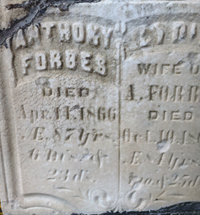
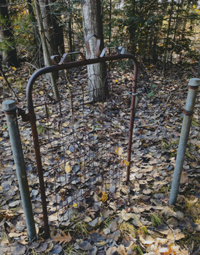
Then, in Octber of 1866, an incident occurred at Aron Forbes’ saloon that led to Forbes quickly leaving for Minnesota with his remaining relatives. Following is the account of the incident by Edgar Ladu, a minister from Mosinee.
The Following is taken From “Early and Late Mosinee” written by Edgar Ladu in 1907.
In October of 1866 quite a scare occurred at Keelerville.
Edward Ladu was attending to some business at Knowlton, a small hamlet six miles distant from Mosinee on the southline road leading to Stevens Point. As he was looking along the road he saw quite a number of men coming in single file rather briskly and his interest in them was at once awakened. He soon discovered that they were Indians. There were six or eight of them. He concluded they must belong to the Pottawattomies.
LaDu stayed overnight in Knowlton and when he reached Mosinee the next morning he found quite an Indian scare was in progress. On an inquiry as to the cause he was informed that a roving band of Indians had taken possession of the saloon at Keelerville, kept by one Aaron Forbes, and were making lots of trouble.
It proved to be the same Indians that Ladu had seen at Knowlton. They had reached Keelerville just before sundown, stopped at the saloon, called for whiskey and it was given them. They soon wanted more, which was handed out to them as before. This was enough to start a desire in them for more, but they were refused any more as they were getting rather noisy. When they were refused they concluded to run the saloon themselves and soon commenced to make lively times. Windows were smashed and the furniture destroyed. They drove the saloon keeper out and took full possession, helped themselves to all the whiskey they wanted and whooped and danced and yelled like demons.
The sister of the saloon keeper, who was keeping house for him, fled for her life. She was nearly prostrated with fright. This lady was well along in years and she ran nearly two miles to the home of her daughter for protection. The saloon keeper ran for help to the home of Mr.William Gouldsberry, the owner of a small sawmill who had several men in his employ in and about his sawmill at Keelerville, which is about one and one-half miles north from Mosinee on the southline road.
As soon as Aron Forbes made the situation known, several men returned with him to the seat of war and joined battle with the enemy in vigorous manner. The battle raged fiercely for some time until one of the Indians was killed by one of the white men. Then the Indians declared war on the whites and outnumbering them, the whites were forced to retreat or be slaughtered, but they succeeded in emptying all the liquor flasks and bottles of their contents before they retired.
The Indians demanded the white man that had killed the Indian. They made a hunt for him but he had made his escape and could not be found. The Indians were very fierce and declared that unless the white man was given up to them that they would have revenge on the inhabitants of Keelerville. It now became very certain that some influence must be brought to bear on the Indians or they would soon be beyond control, as they were crazy drunk as well as desperately mad. One of the white men, more thoughtful then the others, said we must get Mr. Connor here as soon as possible.
This Mr. Connor was a quarter breed French and Indian, married to a Chippewa squaw and was a very fine man of about sixty years of age. Both whites and Indians esteemed him very highly and he had great influence with the Indians. He lived with his family just across the river on the point of land opposite the sawmill. Mr. Connor was sent for at once and came promptly to the rescue, but he had considerable difficulty in quieting the ferocious and now bloodthirsty Indians. Their brother’s blood had been spilled and white blood must flow to satisfy them. They didn’t want to kill anyone but the man that had killed their brother, but unless he was delivered to them they would put on their war paint and feathers and commence hostilities, but by great perseverance in talk by Mr. Connor they finally concluded to call the war off.
And as they recovered from their drunkenness they could understand in some degree that it would have been foolish on their part to have started a massacre of the whites. The white man that killed the Indian could not be identified and nothing was ever done to bring him to an account.
It appears that the saloon keeper was in the habit of letting the Indians have whiskey whenever he could with probable safety. This trouble with the Indians broke up his saloon business in this region and he sold out and moved to Minnesota and the people were glad to have him leave. The Indians hung around for days and then left, after burying their brother.
Come the 1870 Federal Census, Aron Forbes’ sister Hannah and her husband John Durkee can be found in Jonn Lake City, Minnesota.
By 1871 the Wisconsin Central Railroad was establishing major railroad transportation routes through central Wisconsin. Construction reached Keelerville by 1872. A depot, named the Mosinee Depot, was established just to the south of Keelerville. This played a significant role in the growth of the area.
In September of 1872, William Gouldsbury sold his mill at Keelerville to Sebastian Kronenwetter.
William Gouldsbury then moved his family to Wausau. He did quite well in Wausau and became a prominent citizen there.
In a news article, Henry Heil recounted how he worked for Sebastian Kronenwetter at his mill in Keelerville in 1873.
On November 11, 1886, the eastern section of the town of Mosinee was formed into a new town known as Kronenwetter. Keelerville was included in this section and was now part of the new township.
The town hall for Kronenwetter was built in the Keelerville area, and the area began to lose recognition as Keelerville.
Today, few remember the name Keelerville or know where it was located back in the day.
